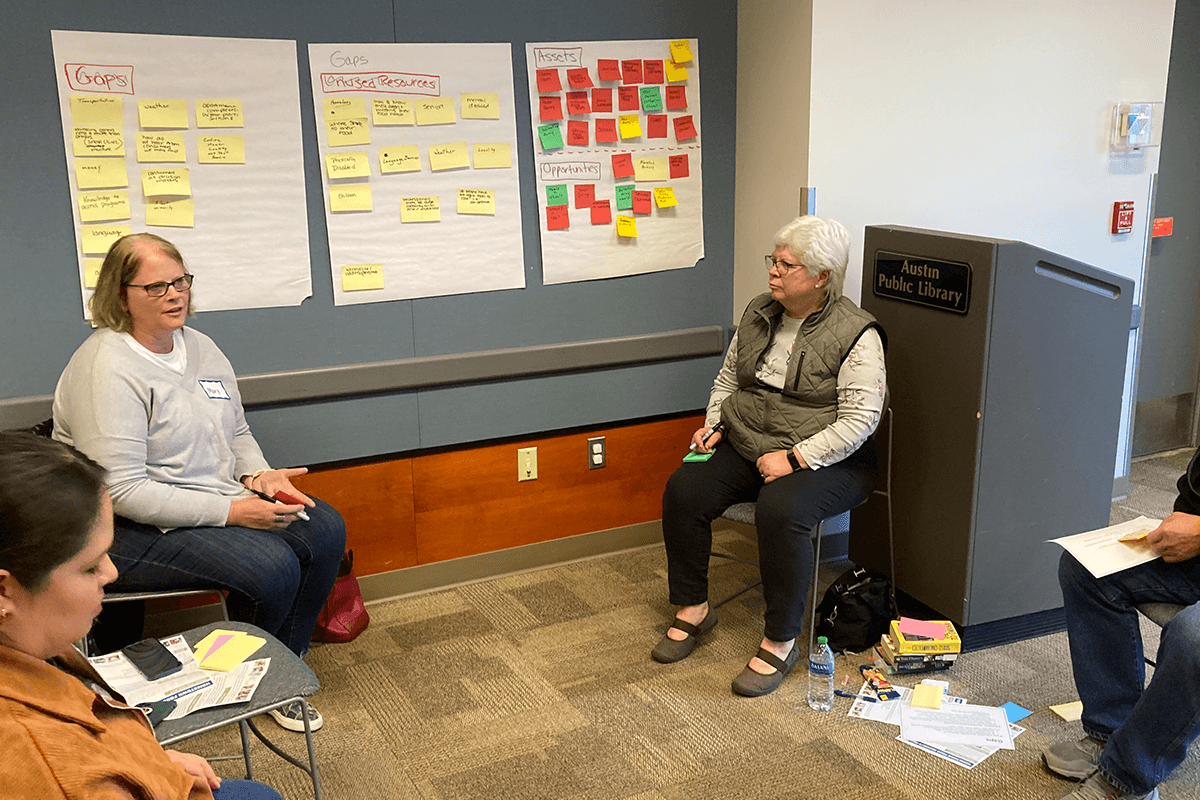Section 2.2
Stakeholder Interviews
SECTION 2
Knowledge Gathering
No one knows the local context, hardship and opportunities like the local stakeholders. They are living this situation firsthand from different perspectives, and their feedback is key to designing an effective program. The main objective of conducting stakeholder interviews is to gather valuable insights, perspectives and potential contributions to the food security initiative.
Host Community Forums
To effectively address the needs of the community, we began by focusing on the largest population groups, with the intention that successful strategies could later be adapted for smaller or more specific communities. Following guidance from the Baylor Playbook, we hosted a series of two-hour community forums led by trained facilitators. Rather than jumping immediately to solutions, the purpose of these sessions was to surface assets, identify barriers, and uncover gaps or underutilized resources. This process helped the team build a clearer understanding of the issues before moving into action planning.
Listening to Lived Experience:
Another helpful strategy was to meet people where they already are. We asked key questions during existing gatherings, such as senior center events, where individuals were engaged. This made it easier to collect honest, relevant feedback in familiar and comfortable settings.
Resources
Community Assessment Forum | Small Group Instructions
From the Hometown Food Security Project
Community Survey
The survey used by the Hometown Food Security Project
Identify a roster of stakeholders
Ensure you have strong diversity of participants, across different constituencies, including community leaders, local government officials, nonprofit organizations, healthcare professionals, educators and local business owners. Depending on the scale of the project, we recommend 15–20 interviews.
Develop stakeholder interview guides
For each interview, prepare questions focused on understanding the stakeholder’s perception of the challenges associated with food insecurity in the region. Conduct preliminary research on each subject’s background and expertise to tailor the questions to the person. Look for their background, education, previous job experiences, interviews in the press, and social media presence. This will ensure the conversation is targeted to the person’s specific background and to the needs of the program in question.
Example questions might include:
-
- What inspired you to work to address food insecurity?
- What drives your leadership and employees to have an impact?
- What is unique about your organization or your approach?
- What are the most underserved populations or hardest to reach in your county?
- Where do you see the gaps in resources for those in need?
- What are the main barriers that prevent you from further scaling your impact?
- How do you measure impact currently?
Conduct interviews
- If possible, arrange one-one-one interviews, ensuring open dialogue to enable stakeholders to freely share their thoughts and insights. Provide an overview of the project and its goals when you start.
- Pro tip: avoid leading questions or statements that might guide the interviewee’s answer.
- If one-on-one interviews are not possible, introduce everyone present to the interviewee.
- Record the meeting with the permission of the subjects. This will enable the interview team to be fully present and not worry about taking notes.
Experienced Voices
A powerful insight from our stakeholder interviews was the importance of including voices with lived experience. Speaking with individuals currently facing food insecurity, or those who have recently navigated it, provided insights that data alone can’t capture, such as the stigma associated with food insecurity among community members.
Stakeholder surveys
In addition to hosting individual stakeholder interviews, we recommend the planning team conduct a broader stakeholder survey to gain additional information on community resources and pressing needs. This survey might be completed through in-person visits, phone calls or digital surveys.
In-person Visits
We visited the rural food pantries near Mower County to make contact with the leaders to share resources, insights and to offer support. When conducting in-person visits to local organizations or food banks, it’s important not to arrive with the intention of telling them what they should be doing or pointing out mistakes. Instead, visiting in smaller groups can be less overwhelming for the site and provide a valuable experience.
Analyze feedback
Synthesize data and insights from the interview to identify common themes, potential follow-ups, partnerships and any stakeholder priorities that will inform your project and the possibility to lean into this stakeholder and their organization for a future activation.
Useful Grouping
We used post-it notes of various colors to capture our learnings, and grouped them into useful themes that we could summarize and convey to the group.

Photo: Hometown Food Security Project
Opportunities and challenges
Through the first phases of the project, including stakeholder engagement, surveys and data collections, we were able to start identifying distinct challenges and opportunities, which helped guide the development of focus areas.
More Tips
There’s a tendency to focus more on the groups that you know, that are geographically close, or that are easiest to reach. Yet, it’s important to cover as much of a community sampling as you can.
For us, that meant finding and deploying volunteers to collect feedback from different linguistic and ethnic groups. We needed to visit with seniors at the senior center, at senior apartments, and those who lived alone in rural areas. Learning from staff or students in one school is probably not as instructive as in multiple buildings across grade levels.
It also meant that relying on one or two evening community forums in the main urban area will not capture the wealth of information that could be found across the county, and on different days and times.